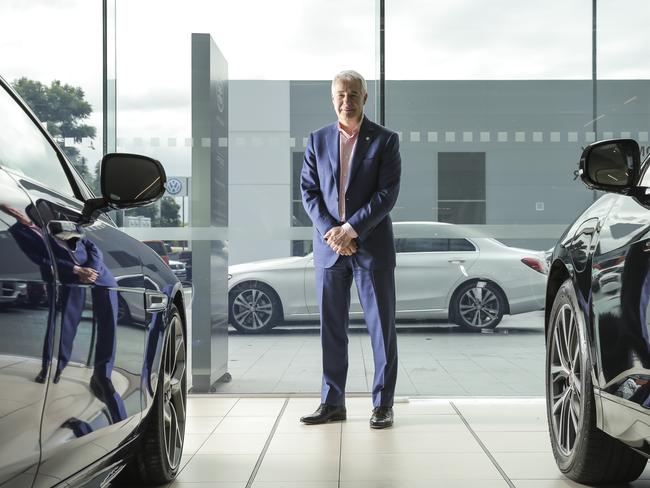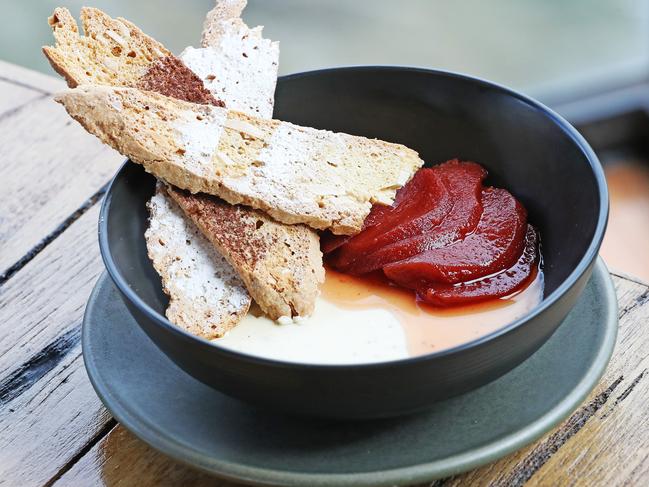Cafe Society: Driving a vision for our clean green state
Electric cars could revolutionise the way we use energy in Tasmania, says infrastructure adviser Braye Sutherland.

Tasmania
Don't miss out on the headlines from Tasmania. Followed categories will be added to My News.
PUT on your seatbelt, kiddies — we’re going on a mind-expanding drive around Tasmania in an electric vehicle.
Our driver today is Braye Sutherland. And the infrastructure adviser and formal global director of the United Nations Office of Project Services is mad about EVs and their potential place in the energy system.
Don’t fret, passengers — we’re a few years into the future, and there are plenty of hotspots to recharge our car batteries on the road, if we haven’t already done so at home. We’re not going to run out of power near Black Bobs after dark.
Stay with me, because a remarkable shift has happened since Braye painted his vision in this newspaper column back in September 2019. It’s 2021 and no longer is Australia’s EV take-up lagging many other countries’; indeed, Tasmania is on track to meet a 2030 zero carbon-emissions goal. The world is watching how we are doing it by cleverly turning our electric cars into dual-purpose performers that play an essential role beyond transporting us.
OK, people, brace yourself, Braye is about to explain his clean green vision for Tasmania.
MORE CAFE SOCIETY:
SARAH ANDREWS: WORKING THE TOOLS TO SHARE OUR STATE
JESS ROBBINS: TASSIE A GLOBAL LEADER IN SUSTAINABILITY
ANDREA SENIOR: MORE SUPPORT FOR TASSIE FOSTER CARERS
HARVEY LENNON: WHY WE NEED TO WALK TO WORK MORE
JENNY DODD: TRAINING THE WORKFORCE OF THE FUTURE
I arrive mid-afternoon at Driftwood Restaurant on the Lauderdale Canal feeling slightly anxious that at this dozy time of the day I won’t absorb the technical details with which Braye is primed to bombard me.
Though the poor man has to explain just about everything twice to me, I come away marvelling at the simple brilliance of it all.
The part about powering cars with electricity rather than petrol or diesel, which is an inherently good move for the environment, is straightforward. It’s the other part that takes a bit more effort to understand.
This is the idea that we can not only draw electricity from the grid to power our cars, we can help stabilise the electricity grid by pouring latent power from our car batteries into it at peak times.
(Just to be clear, Braye is not claiming ownership of the idea, he is championing existing technology and its ideal fit for Tasmania.)
“It’s fair to say electric vehicles are coming,” says Braye, setting the scene. “They will become mainstream, but at the moment Australia is chronically behind. We are five years behind many countries, and 10 years behind others, including Norway, which is like being 10 years behind when computers first came out. It’s a big deal.
“Currently, we are introducing EVs in an uncontrolled way that offers no incentive for people to manage the way they use electric vehicles. But if we got on the front foot they could become an essential part of an electricity transmission and trading scheme.
“The Federal Government has acknowledged there is a benefit in having a demand-based power-sharing with EVs, but it is not doing anything about it.”

At its most essential level, Braye’s vision is all about lowering carbon emissions. He knows it will take ingenuity and market-driven incentives.
He sees Tasmania, coming from behind, as ideally placed to lead the world in 100 per cent renewable energy generation and supplying much of southeast Australia.
Already, we’re at 90 per cent renewables thanks to hydroelectricity.
The key now is to nail our storage and stabilisation capacity through sustainable management of that crucial final 10 per cent, which can make or break the grid.
In storage terms, the car-battery idea feeds straight into the federal Battery of the Nation initiative framework, in much the same way as the proposed pumped hydro stations for Tasmania and the big Tesla battery in South Australia. People could recharge their car batteries cheaply overnight at off-peak times, plugging in at home.
And with a flick of a switch, those same batteries could be called on to help power homes at peak times.
Braye is calling for legislative change to enable a fully decentralised and dynamic power system.
“Tasmania could be the absolute golden child,” he says.
“As a state, there’s perfect synergy with all the hydro already. If we put in more renewables [with wind and solar] and use car batteries for stability, we can sell more power and make more money. Great. Why wouldn’t Tasmania lead the way on this?”
But he admits it will take a leadership and consumer mindset shift.
“TasNetworks is looking 15-20 years ahead, but it is still looking ahead the same way it was in the 1970s,” he says, describing an “old school” way of managing the generation, transmission and sale of electricity.
He knows he is proposing a radical rebuild. “But it is inevitable,” he says. “If it’s not planned and run forward by the Government, it will bite them in the arse big time.”
Meanwhile, Braye is trying to get up a local trial site to harvest energy from a fleet of EVs, a move that would not require any change in legislation.
“It would set a great example that it’s viable,” he says.
If his own generation won’t listen, Braye has faith the Greta Thunberg Climate Strike generation will.
Perched on the peaceful Lauderdale Canal, Driftwood was a welcome addition to the area when it opened almost three years ago. And so it is today, attracting many locals and travellers coming either to or from the airport. Though it’s tucked away, strong social media ratings ensure lots of people seek it out. It was lovely and quiet on our mid-arvo visit.
Sweet treat: Lemon myrtle panna cotta, $14
Open: Six days. For lunch and dinner, Tues-Friday. And for breakfast as well at weekends.
Address: 13 North Terrace, Lauderdale.



